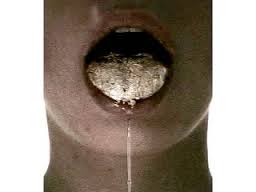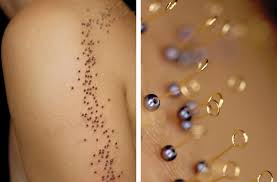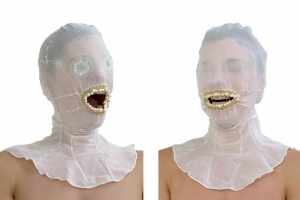Spotlight on Lauren Kalman: Pleasure and Pain In Gold
Lauren Kalman has been a provocative artist for many years, and has gained impressive credits including being featured in the Renwick Gallery at the Smithsonian Museum of Art, Museum of Contemporary Craft, Contemporary Art Museum Houston, Museum of Fine Arts Boston, and the deCordova Museum. She has also been a part of many private collections including the Museum of Fine Arts Boston and the Renwick Gallery at the Smithsonian Museum of Art and gained entry into several international film festivals. Awarded to her, have been residencies at the Corporation of Yaddo, Virginia Center for Creative Arts, and Santa Fe Art Institute; as well as, grants from the Ludwig Vogelstein Foundation, Puffin Foundation West and ISE Cultural Foundation. Since graduating from the Massachusetts College of Art with a BFA in metals, she received an MFA in art and technology from Ohio State University and has become an Assistant Professor at Wayne State University in Detroit, Michigan, with previous professorships at Brown University and the Rhode Island School of Design. 1
In a recent interview to the Art Jewelry Forum regarding her most recent gallery showing at the Sienna Gallery, she talked briefly about her childhood; growing up with two parents in the arts, her father was an industrial designer and her mother was a commercial photographer. Her visual training and influences started at a young age. She later stated choosing the body as a subject was a “logical transition” 2 due to her previous studies as a metal-smith. In the same interview she explained her MFA training plays a large role in her current work, due to in-depth studies of conceptual practices, physical computing, digital imaging, and digital video. She sees her work as a different type of exploration of metal-smithing, and is more interested in conceptual work, rather than the traditional practice of metals and jewelry making. 3 Her long-term ideas have connected body image, media, class, and style; 4 the visual importance she places in these ideas is often juxtaposed by how our visual world expresses the same ideas. These two forms of expression typically fight against each other creating compelling and uncomfortable images and short films. She has continued to separate herself from the rest by addressing cultural taboos and pushing the boundaries of what it means to put body and mind in her artwork.
As Much Gold As You Can Swallow

Kalman’s Hard Wear series from 2006 combined both the extravagant, wealthy nature of gold with the physical deformities often linked with the lower classes. The short film in which Tongue Gilding is demonstrated, the gold leaf rests on her tongue for minutes at a time, and as a result, a steady stream of saliva pours from her mouth. The gold leaf is transformed from how it is depicted by the current visual culture as a high-class, expensive metal adornment, and is placed in a different context; the action of bodily fluids pouring from the body conflicts with the class association with gold leaf, creating a beauty versus class narrative.
Another layer to Tongue Gilding is the focus on the body part being adorned by the gold leaf. The tongue is associated with many things in visual culture: the intake of certain food, the infant-hood inclination to use it as a tool, but more importantly to this series, pleasure. The tongue, especially in the current visual culture climate, is a crude gesture of receiving and giving physical pleasure. The adornment pushes the current idea of the tongue, especially of a female body, and places it in a more celebrated visual area with the gold; the celebration of a sexual body part is directly juxtaposed with the uncomfortable depiction of fluids being poured from the body.
Kalman forced her body to go through hours of uncontrolled drooling and the experience of having gold resting in her mouth. This tenacity to continue to push the body and mind of the artist to create is what begins to push Kalman to the front of the contemporary art world. It would not be so special, because many artists use themselves due to convenience, if this series was not part of the beginning of a dedicated, special relationship of the artist and personal body.
Put Your Body Where Your Art Is

A few years after Hard Wear, Kalman continues to push the boundaries of her established tendency to push her own body’s limits. Blooms, Efflorescence, and Other Dermatological Embellishments series uses body and facial piercings to mimic acne and other skin conditions. Skin conditions are seen as something to erase and the beauty industry which historically targets women makes billions every year on the fear of being seen as unattractive. On the other hand, alternative movements of beauty often revolve around body and facial piercings. Kalman bridges the traditional and alternative through the series successfully by piercing her own body; often showing the physical trauma the piercing causes. From a farther distance, the body jewelry looks like many skin conditions but the blemishes are pearls, natural stones, and gold; the beauty of ornate and shiny jewelry tricks the viewer in seeing the beauty in the skin’s natural inconsistencies. The lower class idea of skin blemishes and bumps is challenged by using expensive looking ornaments as a desirable beauty regime.
As mentioned above, often in the photos Kalman does not edit out the physical traumas, such as blood and irritation around the openings of piercings. In the series, she also shows the peircing tools and jewelry after it was taken out of her body. Blooms is a sort of turning point for Kalman, even though in previous series she had used her own body in a similar way, this is the first time this type of trauma is highlighted. The extent is new for Kalman, and expresses the vulnerability of her work as well as the dedication. From this, she would grow even further as an artist, and begin to depict the long-running narrative and body sacrifice in more abstract way.
Identity in Mesh and Pearls

The most recent large series, But If the Crime Is Beautiful, forms an umbrella over many smaller series within it, including Hoods. Again, Kalman focuses on body modification and the use of extravagant objects with conflicting ideas and objects. Hoods, as well as the other small series it is linked with, deals with the glorification and sexualization of the human body. Gold is still a large influence to Kalman, and Hoods also heavily uses pearls. The link between gold and the over-arcing theme has already been discussed, but the use of pearls has a different connotation in this series. The body and how it is often ‘put on a pedestal’ is the main focal point of Crimes, so it would make sense the pearls used in the hoods and elsewhere points to the links between the object and female body. The identity of the model (Kalman), is obstructed and the ornaments act as the identity in place.
The hood in the image on the left, Hood #5, closely resembles a gimp mask; a gimp is often a sexual dependent on another sexual partner. The other on the right, Hood #4, only outlines one part of the body; this highlights the current over-sexualized body part, the mouth. These images are a tad disturbing, the mesh fabric of the hoods only abstracts the identity of the model a little bit, the gold and pearl embellishments of the mouths resemble serrated flesh outlines of a non-distorted mouth. These are some of the most subtle works Kalman has given through her career; her visual representation of her ideas has changed.
In her most recent years, Kalman has turned more to an abstraction of body modification than literal. She still uses her body as a tool and center point for her work, but her techniques of doing so have become more refined. She still puts herself in claustrophobic situations and contorts her body into the representations she needs for the series, but is focusing less on visual physical trauma seen in past works. The trauma represented in the series is the trauma of a lost identity being over-taken by the reliance of superficial materials more valued by visual culture.
Lauren Kalman continues to put her body through pressures unlike most main-stream artists who have received the recognition she has; she has separated herself for many years. This is due to her provocative nature and concepts, but much in part due to her determination to push her body to keep up with her evolving techniques and ideas.
Works Cited
- Lauren Kalman, “Lauren Kalman Portfolio”, laurenkalman.com, last modified November 2015, http://laurenkalman.com/art/Portfolio.html. ↩
- “Interview with Lauren Kalman, siennapatti.com, last modified November 2015, https://siennapatti.com/news/interview-lauren-kalman ↩
- Susan Cummins, “Lauren Kalman: But If The Crime Is Beautiful”, artjewelryforum.org, last modified November 2015, http://www.artjewelryforum.org/ajf-blog/lauren-kalman-but-if-the-crime-is-beautiful-%E2%80%A6. ↩
- Lauren Kalman, “Lauren Kalman Portfolio”, laurenkalman.com, last modified November 2015, http://laurenkalman.com/art/Portfolio.html. ↩
What do you think? Leave a comment.











She makes things look so easy. But of course, IT’S NOT!
I’ll certainly keep an eye for Kalman’s work.
Wow, thanks for telling us about Kalman. Her dedication toward her art is astonishing. It’ll be neat to see how she evolves as an artist.
As an aspiring piercer it is fantastic to read about body modification artists.
Thanks for the profile.
fascinating stuff
This is a really competitive industry and Lauren Kalman is doing great. Thank you for the article.
Yikes. Looks painful and weird. But art is something I will never claim to understand.
Learning more about Lauren Kalman’s Art made for a great read. I like that you illustrated her devotion to her artwork, and touched on her work ethic. I really appreciated delving deeply into the symbolism behind her work with this article, so thank you for that.
Side note: grammar issues made this a bit of a tough read to get through. Great job otherwise!
Cool article!
Creative thinking, and unique. Will be researching her more.
Thank you for highlighting this interesting and unique artist! Great article.
Hello, my name is Olivia. Thanks for the article. When I wrote my essay, I found inspiration in a trip to Manchester, where I saw Kalman’s work. I flew to Manchester and immediately rented a car from a great company. I traveled around the city all day, and in the evening I started writing an essay right in the car.